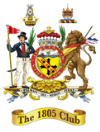Dorchester
The county town of Dorset, Dorchester lies south of the Dorset Downs and north of the South Dorset Ridgeway. The origins of the town go back to prehistory and it was a Roman settlement after they defeated the local tribe, the Durotridges. Some of the ancient Roman wall that surrounded the town remains and other parts have been replaced by a path known as ‘The Walks’.
Later the town would be notorious as the scene of the Bloody Assizes, presided over by Judge Jeffreys in the Oak Room of the Antelope Hotel following the Monmouth Rebellion. His lodging house is now a restaurant in the town and is one of the few medieval buildings to survive a series of devastating fires in the 17th and 18th Centuries. Many of the current buildings were built in the Georgian era such as the Shire Hall. It was here that the famous Tolpuddle Martyrs were tried and later novelist and poet Thomas Hardy would sit as a magistrate.
Other notable buildings are the Depot Barracks and the High West Street Drill Hall, the Church of St Peter and Max Gate, the former home of Thomas Hardy. Having trained as an architect he designed the house himself - choosing the Queen Anne style. It is now open to the public. Dorchester also boasts the only visible Roman town house in Britain situated just north of the county hall.
Near the town centre is an ancient British henge called Maumbury Rings, now an open public space. It was used as an amphitheatre by the Romans and later as an artillery fort in the English Civil War.
Near to Dorchester lies the remains of Maiden Castle, an Iron Age hill fort whose origins go back to Neolithic times. It was greatly expanded around the year 450BC making it the largest hill fort in Britain and, by some definitions, Europe.
Return to overview

Picture-postcard-perfect Dorset thatch makes great subject matter. Photo © Ian Gregory
Puddletown, Dewlish, Milbourne St Andrews, Brianstone
Travelling north east from Puddletown The Trafalgar Way now leaves the A35 and follows the A354 passing Dewlish. Here there was a Turnpike gate at the time of Lapenotieres journey to London, but it is likely that his postillion would have blown his horn to indicate that the carriage approaching was on important state business, requiring the gatekeeper to hurriedly open the gate.
Milbourne St Andrew is a village in what is known as a Winterbourne Valley - created by a stream that is often dry in the summer months, due to underlying porous rock. It used to consist of two villages which eventually coalesced around the Melbourne Brook. Thomas Hardy described this attractive village as “Millpond St Jude’s” in Far from the Madding Crowd and Weatherby Castle is the ‘tower’ of his novel Two of a Tower.
Brianstone is just a mile west of Blandford Forum and is adjacent to the grounds of Bryanston School, whose main buildings are in what was once a large country house built in the 1890s. Famous alumni of the school include Ben Fogle, Emilia Fox, Terence Conran and Lucian Freud.

The route through Piddletown
The route from Dorchester
Lapenotiere's route through Dorchester brought him in from the West on the Bridport Road, along the High Street and out on the London Road.
In those days the village we now know as 'Puddletown' was called 'Piddletown' as you can see from this contemporary map excerpt. It only changed its name in the early 20th century.






